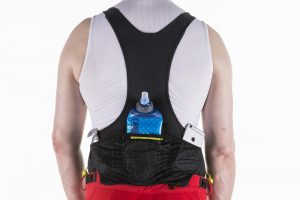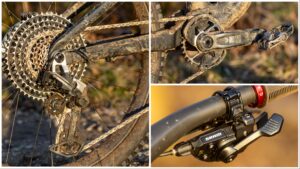Offer a ride quality that is superior to the best alloy wheels, with improved durability over most carbon alternatives
Zipp 3Zero Moto wheelset review
What’s most interesting about the Zipp 3Zero Moto carbon wheels is weight-saving is a secondary concern; it’s performance that headlines this class act.
>>> Best mountain bike wheels in 2020: aluminium and carbon options
Carbon wheels were once touted as the saviour of 29ers, their reduced rotational weight offsetting the sluggish acceleration inherent with bigger wheels. But as manufacturers quickly discovered, lightweight carbon 29in wheels don’t hold up to the rigours of regular trail riding. As such, extra carbon had to be added to the rims, making them stronger, stiffer and ultimately heavier. Today, the weight difference between the best carbon and alloy wheels is marginal, even if there’s still a gulf in price.

Tyrewize pressure gauge is fitted in standard
So if a robust carbon rim isn’t much lighter than an alloy one, what advantages do they offer other than being stiffer, less prone to buckling, and cracking rather than denting? Until the Zipp 3Zero Moto wheelset arrived, the short answer was not very much.
Most carbon rims are, well, carbon copies of alloy rims and use the same box-section construction. But Zipp has flipped this process on its head, borrowing a concept straight from motocross.
By using a low-profile single-wall rim, Zipp has been able to engineer the carbon to flex locally around the spoke bed. This allows the section of the rim just above the contact patch of the tyre to flex under load. Zipp has coined the term ‘ankle-flex’ to better describe the concept, because just as your ankles articulate to keep your foot firmly planted on the ground as you run round a corner, the lower part of the rim flexes to align the contact patch of the tyre with the terrain.

Rear hub still run smoothly after a year of use
It works. And it’s not the only advantage of Zipp’s unique rim design. Having a carbon rim that can move locally makes it less prone to failing and dramatically reduces the risk of pinch flats, something I’ve experienced first hand. That’s not to imply that the 3Zero Moto wheels are indestructible, though. And while it’s tempting to run lower tyre pressures, I’d advise against this, especially if you are approaching the upper end of Zipp’s 120kg weight limit — a sum that includes the bike and your riding kit. I’d also recommend using an insert in the rear tyre for racing, just for extra protection when the rim reaches its maximum ability to flex, as a rock will always win that particular encounter. If you’re unlucky and the rim does fail, you’re covered under Zipp’s lifetime warranty.
In back-to-back testing with Santa Cruz Reserve 30s the Zipp 3Zero Moto wheels offered an appreciable reduction in harshness, while increasing traction and control. In fact, the best analogy I can use to describe the sensation of riding the Zipp wheels is by comparing them to tyres. It was as if I’d switched to softer compound rubber, without the associated increase in rolling resistance. And even though the tyres on both wheelsets were identical, the sound of the tyres also changed, with less pinging from the side knobs on the Zipp wheels when blasting through rough, rocky terrain.

Front hub is Torque Cap compatible
So the rims are amazing, but how does the rest of the wheelset stack up? The Zipp ZM1 hubs don’t carry the cachet of King, Industry Nine or DT Swiss, but the bearings are still every bit as smooth today as when I fitted the Zipp wheels 11 months ago. Granted, the Double Time freehub technology, with its 52-point engagement (6.92°), is positively lethargic compared to many modern hubs, so Half Time technology would probably be a better moniker.
Cutting-edge tech
With Zipp coming under the big, red SRAM umbrella, it should come as no surprise that the front hub is Torque Cap compatible, the bigger 31mm end caps boosting stiffness with all RockShox forks. The end caps pop on and off easily and because you also get the standard 21mm end caps with the wheels, you can tune steering stiffness to a degree, or just match the hub compatibility to any fork.

‘Ankle-flex’ rim concept is borrowed from motocross
And as if the Zipp wheels weren’t already packed with cutting-edge tech, the wheelset has TyreWiz fitted as standard. The wireless pressure gauge gives you live readings on your phone, where you can set upper and lower pressure limits, with the small light on the unit at the base of the valve indicating if the pressures needs adjusting. Most impressive though, is that after 11 months of use, the batteries are still going strong. Yes, I had some issues connecting to the original TyreWiz app, but now that it has been rolled into the SRAM AXS app it connects every time. Still, I could happily live without the £250 TyreWiz, especially if it meant that the wheels were proportionally cheaper.
















